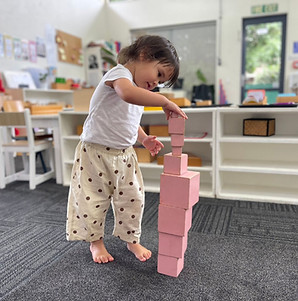Sensorial
Materials in this area are designed to refine the senses of sight, touch, smell, hearing and taste. Each activity is designed to isolate a concept for your child to discover. For example, the ‘Pink Tower’ is made up of ten pink cubes ranging from small to large. The child builds the tower with the largest cube on the bottom and the smallest on the top. Because the cubes are identical except in size it enables your child to isolate the concept of size.
Other materials isolate different concepts: colour tablets for colour matching, the sound boxes for matching and grading sounds and the blue geometric solids for learning the names of the geometric shapes.
As the child’s exploration continues, the materials interrelate and build upon each other. For example, relationships can be discovered between the ‘Pink Tower’ and the ‘Brown Stair’ based on matching precise dimensions. Materials are self-correcting. When a piece does not fit or is left over, your child easily perceives the error. This is no need for adult ‘correction’. Problems are solved independently, building self-confidence and analytical thinking and giving the satisfaction that comes from accomplishment.
In the Montessori classroom, the child experiences the materials in a tactile sense, first by feeling, matching and manipulating. They learn the language that matches the materials; for example, geometric solids are felt, observed and compared. Your child will then learn the names of each of the solids; sphere, rectangular prism, cube etc.

